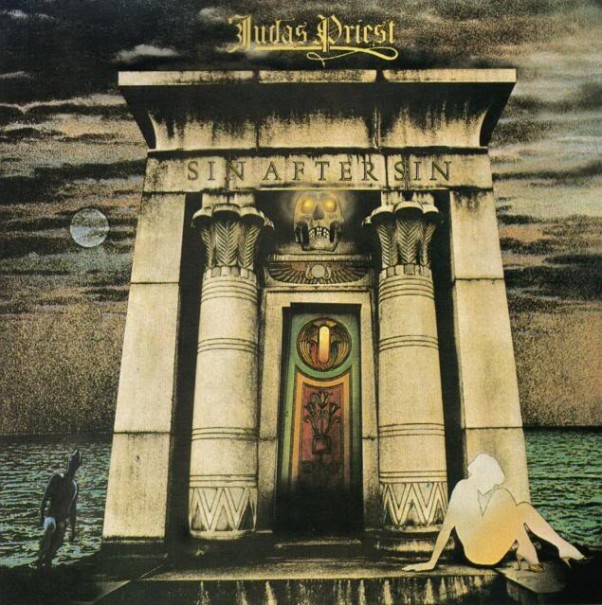Drummer Simon Phillips was not even 20 years old when he entered the studio with Judas Priest on January, 1977 to record the iconic album Sin After Sin. The result was intricate power drumming put to some of the sharpest metal songs to ever appear on album.
Phillips has performed or recorded with the likes of The Who, Pete Townshend, Roger Daltrey, Big Country, Toto, Jeff Beck, Michael Schenker, Jack Bruce, Brian Eno, Mike Oldfield, Jon Anderson, Gary Moore, 10cc, Mick Jagger, Phil Manzanera, John Wetton, Asia, Stanley Clarke, Nik Kershaw, and Jordan Rudess. And the list goes on. Legendary guitarist Jeff Beck once figured Simon Phillips to be “the best English drummer.” Sin After Sin would not have been the same without his involvement.
Sin After Sin is now 35 years old, and it is still as incredible as it was when released in April of 1977. Simon Phillips remembers it fondly. In honor of the album’s anniversary, Powerline got in touch with Phillips for a quick interview.
How did you begin your working relationship with Judas Priest (Sin After Sin LP, 1977)?
Simon Phillips: I called Roger Glover to play on their next record. I had worked with Roger on his solo album, Elements, in 1976 and also David Coverdale’s first solo album, Whitesnake! Roger was always wonderful to work with. We worked on quite a few projects together and I liked his way of going about things. Always very creative.
Did you like the chosen studio for Sin After Sin — Ramport Studios [in London]?
Phillips: I had done many sessions at Ramport Studios, so I was very familiar with the studio. It was a great studio for bands and had a great vibe. Of course, being Pete Townshend’s studio, it had a wonderful aura and one always imagined what it was like when The Who were recording there [1973 classic album Quadrophenia was recorded there]. Most studios of that time were quite dead acoustically so I was rarely happy with the sound of the room. My preferences at the time were Air Studio 1, Abbey Road 1 and 2 and Morgan 4. I liked, and still prefer, large live rooms.
What was your overall impression of Judas Priest’s music before entering the studio with them? And afterwards?
Phillips: At the time, of course, we had no idea how successful that album would become. I remember enjoying playing the music and it was always challenging to play a song the best way I could think of approaching it. I fairly recently played a couple of those songs at a special performance at the NAMM show commemorating my 30 years as a Tama Drums endorser and it was so much fun to play those songs again and I realized just how damn good they were compositionally.
The band wrote some real progressive music for a hard rock band at the time.
Phillips: Yes, I agree. I would have to say that the approach I used put the music in a different setting. I played some of those songs with a rather fusion approach which mixed the styles somewhat. That was what I did when I played sessions. I always looked for a different way to play the song other than the obvious. Sometimes that didn’t work and for more “pop” sessions I had to play it safe and stick to what people were used to hearing. But with projects such as Judas Priest I was free to explore and was met with approval by the band and producer rather than clamped down upon to play it safe. I am not a “safe” player! I believe that is why Pete Townshend would call me to play on his records. He told me once he loved the “anarchy” of my playing.
What was the extent of your songwriting involvement on Sin After Sin? Any?
Phillips: Absolutely none. I was hired to play only.
Can you go over your thoughts/impressions/memories of songs, as much as you can?
Phillips: I would have to listen to the album again to give you song by song impressions. However, at the NAMM show in 2009 I played “Sinner” and “Dissident Aggressor.” I think my favorite song was “Dissident Aggressor.”
Were you surprised at the choice of the band covering Joan Baez’s “Diamonds and Rust”? After recording it, did you think it would become a popular song for them?
Phillips: I have to be honest, I didn’t even know that was a Joan Baez song. Not really a Joan Baez fan – sorry.
Did you ever consider joining the band, or going on tour with them?
Phillips: I was asked to join the band but I was already committed to another band — the Jack Bruce Band — at that time, so I couldn’t even consider the offer.
Your drumming style seemed to be a natural fit for the band’s music at the time. Was it not a natural fit, personality-wise?
Phillips: Oh, I think we would have been fine together, and I am sure we would have had a lot of fun on the road. But I do think it would have been short lived because at the time I was more into playing lots of different styles and gaining experience in other fields of music and music production.
Did you have a good working relationship with the members of the band? General impression of each member, experiences, etc. Ian Hill, K.K. Downing, Rob Halford, Glenn Tipton …
Phillips: From what I remember, we had a great time. Glenn was obviously the natural leader and catalyst of the band — certainly in the recording process. Rob had a strong influence, too. K.K. did not play on the tracks as he was in the control room with Roger. The tracks were cut as a trio — bass, drums and guitar — with Rob singing guide vocals live with us. It was the way we recorded in those days and that gave it that lovely organic live feel. Ian was as most bass players are — the quiet one!
Do you still keep in touch with any of the members of Judas Priest? Did you ever jam or collaborate with them again? (Or even discuss it?)
Phillips: Unfortunately, I have only ever bumped into the band once at SIR rehearsal studios in Hollywood in 1990. I was rehearsing with Joe Walsh, John Entwistle, Keith Emerson and Jeff “Skunk” Baxter for a Japanese tour.
I met up with Rob at a festival somewhere when he was doing his solo project. Maybe one day we’ll do something special as a one off.
Did you know Les Binks, the drummer that took over for the Sin After Sin tour?
Phillips: No, not at all.
Did you ever think the band Judas Priest would become the leather/metal band they are today? Was there any sign of a changing fashion or attitude in the band? Was the term “Heavy Metal” even used back then?
Phillips: Aha… interesting. The term “Heavy Metal” was definitely not used back then. We didn’t know that this music or that album or indeed the band would have such success. We just made music in the hope that it would succeed and we made it the best we could.
Are you proud of your involvement on the Sin After Sin album? Are you happy about the outcome of the album?
Simon Phillips: It’s funny because it’s only in recent years that I realize how influential that album was to so many metal drummers of today. I keep meeting young players who come up to me and say – “Judas Priest – Sin After Sin – changed my life!” When I listen to it today I am very happy with it.













